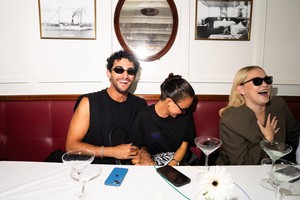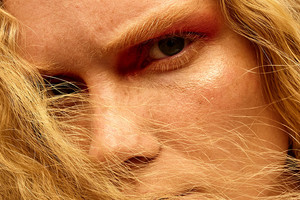Stockholm Art Week: Ayan Farah Lets the Materials Speak
Written by Natalia Muntean by Zohra Vanlerberghe“I’m not preserving materials,” says Ayan Farah, “I’m extending their histories.” Farah's art lives in the space between memory and transformation. Using natural pigments, weathered textiles, and geological traces, her work embraces the poetry of process, with rust, indigo, and clay becoming active collaborators. As she prepares for her upcoming exhibition at Galerie Nordenhake during Stockholm Art Week 2025, Farah discusses imperfection as liberation, slowness as resistance, and why every artwork is a seed for the next.
Natalia Muntean: Your work often incorporates materials with deep histories: antique linens, sitespecific clays, or indigo from Senegal. How do you navigate the tension between preserving these material histories and transforming them into something new?
Ayan Farah: In an abstract sense, tension is where the work happens, parallel to this I try not to think of it as tension, but as a continuum. I’m interested in the idea of material memory, how something seemingly still can hold a geography, a weather and a body. Transformation then becomes a way of listening. It’s not about controlling the outcome, it’s about letting something emerge through the process.
My process isn’t about preserving them intact but about extending their histories. By working with them, soaking, staining, and layering, I’m allowing new stories to emerge. It’s not a transcendence but a continuation, one that acknowledges both the origin and the transformation. This method not only grounds my work in specific landscapes but also raises questions about the geopolitical and environmental implications of sourcing and utilising these materials. The process in itself draws attention to these materials and sites.
NM: You describe your works as “questions” rather than statements. Which artists, writers, or thinkers have influenced this open-ended approach? Are there non-artistic sources that shape your practice?
AF: Writers like Édouard Glissant have influenced me, especially his ideas around opacity and relation. I’m drawn to thinkers who allow for multiplicity, for fragments rather than totalities. Artists and writers who move in the space between the visible and the invisible, repetition and differences. Roni Horn and Walter De Maria’s sensitivity to scale and silence, René Daumal’s ascent toward the unknown - these resonate deeply. Their work doesn’t resolve, it opens. I tend to navigate towards non-linear systems of knowledge, how something can be both grounded and speculative, rigorous and ephemeral. I’m interested in the natural sciences, geology, botany, and meteorology. The way sediment layers tell time or how rust records air and salt.
NM: You embrace irregularities, blurred photography, “mistakes” in tie-dye, frayed edges. Is there a beauty in decay or incompleteness that feels particularly urgent in today’s culture of perfection?
AF: There’s a kind of freedom in relinquishing control, especially in a world preoccupied with polish and permanence. I’ve come to understand imperfection not as failure, but as honesty. The blurred line, the uneven tone and the under-processed. What’s incomplete is often what triggers my interest. I'm drawn to moments where a linear form begins to dissolve, these are places where time becomes visible. This does not mean I’m not intrigued by the opposite, but I still want to leave space for what’s unresolved.
NM: Your works often involve slow processes: growing plants for dyes, weathering fabrics, or waiting for rust to form. How does the slowness of your practice challenge or enrich your relationship with the art world’s fast-paced demands?
AF: Slowness allows me to step out of the linear time of production and into something more cyclical, more attuned to natural rhythms. The art world can be urgent but my process insists on waiting, on listening. That space, where materials change at their own pace, becomes the work itself.
When I wait for rust or for dye to deepen in the fabric, I’m attuning myself to forces beyond my control. This time is full of potential as I trust in this natural rhythm that is often tied to the seasons. I adapt my work to it and in the process allow new ideas to grow. There is always another part of the process to hold my attention in the in-between hours.
NM: You’ve described your practice as experimental, where “each work is a seed for another.” How do you anticipate this cyclical process evolving for your upcoming exhibition in Stockholm? Are there unresolved questions from Seeds that you’re carrying forward?
AF: Seeds opened up new material relationships that are still unfolding. Certain clays I only just started working with and other materials have resurfaced. I’m currently integrating new elements of embroidery while further developing abstraction, allowing larger fields of “quietness” in each work. Working with diptychs and twin works that reference each other. I tend to work through a spectrum of techniques and pigments and this hasn’t changed.












